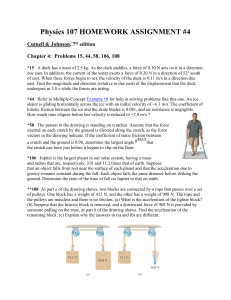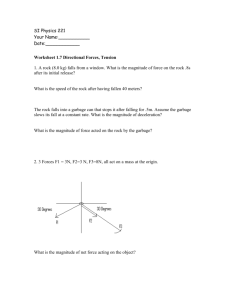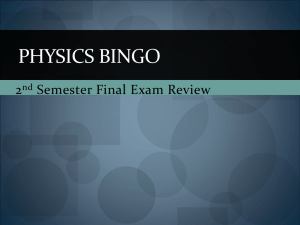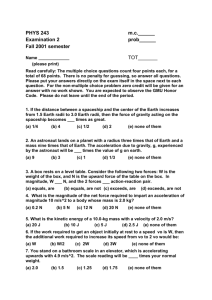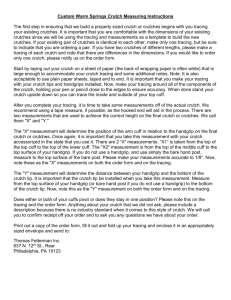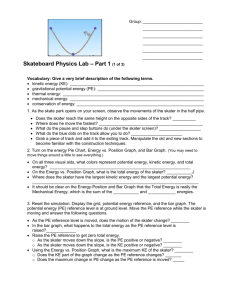hw4
advertisement
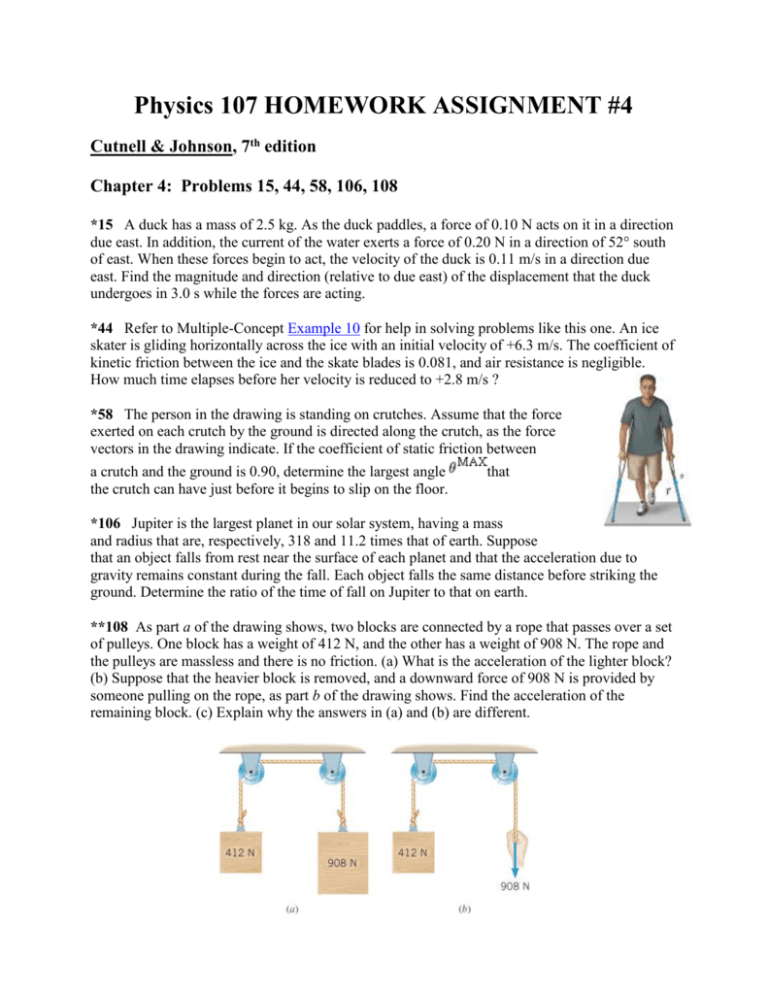
Physics 107 HOMEWORK ASSIGNMENT #4 Cutnell & Johnson, 7th edition Chapter 4: Problems 15, 44, 58, 106, 108 *15 A duck has a mass of 2.5 kg. As the duck paddles, a force of 0.10 N acts on it in a direction due east. In addition, the current of the water exerts a force of 0.20 N in a direction of 52° south of east. When these forces begin to act, the velocity of the duck is 0.11 m/s in a direction due east. Find the magnitude and direction (relative to due east) of the displacement that the duck undergoes in 3.0 s while the forces are acting. *44 Refer to Multiple-Concept Example 10 for help in solving problems like this one. An ice skater is gliding horizontally across the ice with an initial velocity of +6.3 m/s. The coefficient of kinetic friction between the ice and the skate blades is 0.081, and air resistance is negligible. How much time elapses before her velocity is reduced to +2.8 m/s ? *58 The person in the drawing is standing on crutches. Assume that the force exerted on each crutch by the ground is directed along the crutch, as the force vectors in the drawing indicate. If the coefficient of static friction between a crutch and the ground is 0.90, determine the largest angle the crutch can have just before it begins to slip on the floor. that *106 Jupiter is the largest planet in our solar system, having a mass and radius that are, respectively, 318 and 11.2 times that of earth. Suppose that an object falls from rest near the surface of each planet and that the acceleration due to gravity remains constant during the fall. Each object falls the same distance before striking the ground. Determine the ratio of the time of fall on Jupiter to that on earth. **108 As part a of the drawing shows, two blocks are connected by a rope that passes over a set of pulleys. One block has a weight of 412 N, and the other has a weight of 908 N. The rope and the pulleys are massless and there is no friction. (a) What is the acceleration of the lighter block? (b) Suppose that the heavier block is removed, and a downward force of 908 N is provided by someone pulling on the rope, as part b of the drawing shows. Find the acceleration of the remaining block. (c) Explain why the answers in (a) and (b) are different. 15. REASONING Equations 3.5a x v0 xt 12 axt 2 and 3.5b y v0 yt 12 ayt 2 give the displacements of an object under the influence of constant accelerations ax and ay. We can add these displacements as vectors to find the magnitude and direction of the resultant displacement. To use Equations 3.5a and 3.5b, however, we must have values for ax and ay. We can obtain these values from Newton’s second law, provided that we combine the given forces to calculate the x and y components of the net force acting on the duck, and it is here that our solution begins. SOLUTION Let the directions due east and due north, respectively, be the +x and +y directions. Then, the components of the net force are Fx 0.10 N 0.20 N cos 52 0.2231 N Fy – 0.20 N sin 52 –0.1576 N According to Newton’s second law, the components of the acceleration are ax ay Fx m Fy m 0.2231 N 0.08924 m/s 2 2.5 kg –0.1576 N –0.06304 m/s 2 2.5 kg From Equations 3.5a and 3.5b, we now obtain the displacements in the x and y directions: x v0 xt 12 axt 2 0.11 m/s 3.0 s 12 0.08924 m/s 2 3.0 s 0.7316 m 2 y v0 y t 12 a y t 2 0 m/s 3.0 s 12 –0.06304 m/s 2 3.0 s –0.2837 m 2 The magnitude of the resultant displacement is r x2 y 2 0.7316 m 2 –0.2837 m 2 0.78 m The direction of the resultant displacement is 0.2837 m 21 south of east 0.7316 m tan –1 44. REASONING Let us assume that the skater is moving horizontally along the +x axis. The time t it takes for the skater to reduce her velocity to vx = +2.8 m/s from v0x = +6.3 m/s can be obtained from one of the equations of kinematics: vx v0 x ax t (3.3a) The initial and final velocities are known, but the acceleration is not. We can obtain the acceleration from Newton’s second law Fx max , Equation 4.2a in the following manner. The kinetic frictional force is the only horizontal force that acts on the skater, and, since it is a resistive force, it acts opposite to the direction of the motion. Thus, the net force in the x direction is Fx f k , where fk is the magnitude of the kinetic frictional force. Therefore, the acceleration of the skater is ax Fx m f k / m . The magnitude of the frictional force is f k k FN (Equation 4.8), where k is the coefficient of kinetic friction between the ice and the skate blades and FN is the magnitude of the normal force. There are two vertical forces acting on the skater: the upward-acting normal force FN and the downward pull of gravity (her weight) mg. Since the skater has no vertical acceleration, Newton's second law in the vertical direction gives (taking upward as the positive direction) Fy FN mg 0 . Therefore, the magnitude of the normal force is FN mg and the magnitude of the acceleration is ax f k k FN k m g k g m m m SOLUTION Solving the equation vx v0 x ax t for the time and substituting the expression above for the acceleration yields t vx v0 x ax vx v0 x k g 2.8 m/s 6.3 m/s 4.4 s 0.081 9.80 m/s 2 58. REASONING The diagram at the right shows the force F that the ground exerts on the end of a crutch. This force, as mentioned in the F statement of the problem, acts along the crutch and, therefore, makes an angle with respect to the vertical. The horizontal and vertical components of this force are also shown. The horizontal component, F sin , is the static frictional force that prevents the crutch from F sin slipping on the floor, so fs F sin . The largest value that the static frictional force can have before the crutch begins to slip is then given F cos by fsMAX F sin MAX . We also know from Section 4.9 (see Equation 4.7) that the maximum static frictional force is related to the magnitude FN of the normal force by fsMAX s FN , where s is the coefficient of static friction. These two relations will allow us to find MAX . SOLUTION The magnitude of the maximum static frictional force is given by fsMAX s FN . But, as mentioned in the Reasoning section, fsMAX is also the horizontal component of the force F, so fsMAX F sin MAX . The vertical component of F, F cos MAX is the magnitude FN of the normal force that the ground exerts on the crutch. Thus, we have fsMAX s FN F cos MAX F sin MAX The force F can be algebraically eliminated from this equation, leaving sin MAX s cos MAX or tan MAX s The maximum angle that a crutch can have is MAX tan 1 s tan 1 0.90 42 106. REASONING AND SOLUTION acceleration, it follows that Since both motions are characterized by constant yJ yE 1 a t2 2 J J 1 a t2 2 E E where the subscripts designate those quantities that pertain to Jupiter and Earth. Since both objects fall the same distance, the above ratio is equal to unity. Solving for the ratio of the times yields tJ tE aE GM E / RE2 RJ aJ GM J / RJ2 RE ME 1 11.2 0.628 MJ 318 108. REASONING AND SOLUTION a. The rope exerts a tension, T, acting upward on each block. Applying Newton's second law to the lighter block (block 1) gives T – m1g = m1a Similarly, for the heavier block (block 2) T – m2g = – m2a Subtracting the second equation from the first and rearranging yields m – m1 a 2 g 3.68 m/s 2 m m 1 2 b. The tension in the rope is now 908 N since the tension is the reaction to the applied force exerted by the hand. Newton's second law applied to the block is T – m1g = m1a Solving for a gives a 908 N – 9.80 m/s 2 11.8 m/s 2 T –g m1 42.0 kg c. In the first case, the inertia of BOTH blocks affects the acceleration whereas, in the second case, only the lighter block's inertia remains.
